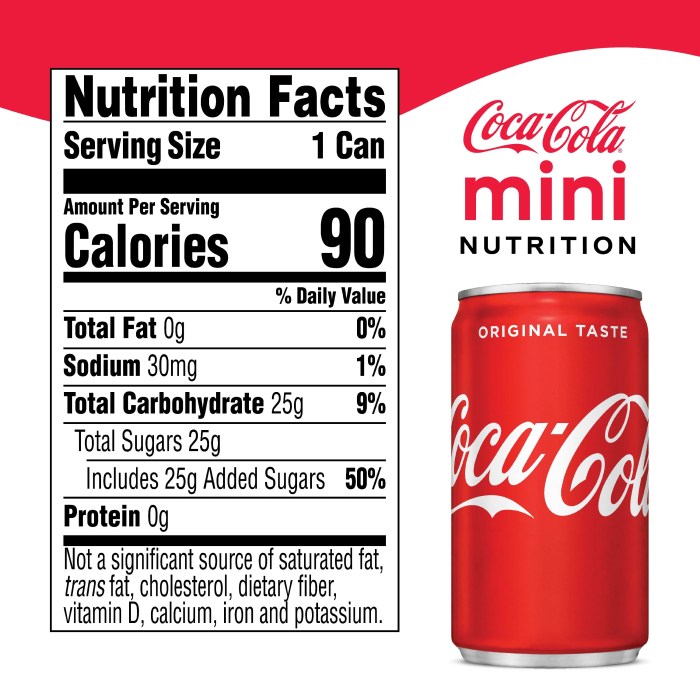Nutritional Content Breakdown: Coke 12 Oz Nutrition Facts

Coke 12 oz nutrition facts – Let’s delve into the specifics of what constitutes a 12-ounce can of Coca-Cola, exploring its nutritional composition and comparing it to similar beverages. Understanding the ingredients is key to making informed choices about our consumption.
Coca-Cola, like many carbonated soft drinks, is primarily composed of water, high-fructose corn syrup (or sugar, depending on the region and formulation), and carbon dioxide. These base ingredients contribute significantly to the overall nutritional profile. Beyond these core components, a small amount of caramel color, phosphoric acid, caffeine, and natural flavors are added to achieve the distinctive Coca-Cola taste and appearance.
Coca-Cola’s Nutritional Profile
The following table provides a detailed breakdown of the nutritional components found in a typical 12-ounce serving of Coca-Cola. Note that these values may vary slightly depending on the specific formulation and manufacturing processes.
| Nutrient | Amount | % Daily Value | Notes |
|---|---|---|---|
| Calories | 140 | 7% | Primarily from sugars. |
| Total Fat | 0g | 0% | Coca-Cola contains no fat. |
| Saturated Fat | 0g | 0% | Coca-Cola contains no saturated fat. |
| Cholesterol | 0mg | 0% | Coca-Cola contains no cholesterol. |
| Sodium | 0mg | 0% | Coca-Cola contains negligible sodium. |
| Total Carbohydrate | 39g | 13% | Almost entirely from sugars. |
| Sugars | 39g | – | The primary source of carbohydrates and calories. |
| Protein | 0g | 0% | Coca-Cola contains no protein. |
| Caffeine | 34mg | – | A stimulant naturally found in the cola nut. |
Sources of Nutrients in Coca-Cola, Coke 12 oz nutrition facts
The primary source of calories and carbohydrates in Coca-Cola is sugar, typically high-fructose corn syrup or sucrose. The caramel color contributes to the drink’s distinctive dark brown hue. Phosphoric acid provides tartness and acts as a preservative. Caffeine, a natural stimulant, is added for its invigorating effects. Natural flavors are used to round out the complex taste profile.
Comparison with Similar Beverages
Compared to other carbonated soft drinks, Coca-Cola’s nutritional profile is relatively typical. Similar products, such as Pepsi, often have comparable levels of sugar, carbohydrates, and calories. However, variations exist depending on specific formulations and the use of different sweeteners. Some diet versions utilize artificial sweeteners to reduce sugar content and calories, leading to a significantly altered nutritional profile.
So, you’re checking the nutrition facts for that 12-ounce Coke? A refreshing treat, but maybe you’re thinking about balancing things out. For a healthy contrast, consider the nutritional powerhouse that is romaine lettuce – check out the detailed nutrition facts for romaine lettuce to see what we mean! Then, you can make an informed decision about that Coke – a little indulgence alongside a healthy dose of greens might be the perfect combo.
For example, Diet Coke would have considerably fewer calories and sugars, but it would contain artificial sweeteners instead. Other beverages, such as sparkling water or naturally flavored sodas, provide significantly lower sugar and calorie alternatives.
Serving Size and Consumption Patterns

The seemingly innocuous 12-ounce serving of Coca-Cola holds a significant place in discussions about daily caloric intake and sugar consumption. Understanding this serving size’s impact is crucial for making informed choices about our beverage habits and their potential long-term health implications. The seemingly small size belies a surprisingly large contribution to our overall daily intake of both calories and sugar.The 12-ounce serving size, while standard for many soft drinks, often masks the reality of cumulative consumption.
Many individuals consume multiple servings throughout the day, significantly increasing their overall sugar and calorie intake. This seemingly small increase per serving can quickly escalate to substantial numbers, potentially impacting weight management, energy levels, and long-term health.
Serving Size and Nutrient Intake Visualization
Imagine a bar graph. The horizontal axis represents different serving sizes of Coca-Cola (e.g., 12 oz, 24 oz, 36 oz). The vertical axis represents the total amount of sugar and calories consumed. For each serving size, two bars are displayed side-by-side: one representing sugar intake (in grams) and the other representing caloric intake. As the serving size increases along the horizontal axis, the height of both bars dramatically increases, visually demonstrating the direct relationship between serving size and total nutrient intake.
The graph would clearly show how a seemingly small increase in serving size leads to a proportionally larger increase in both sugar and calories consumed. For instance, two 12-oz servings would double the sugar and calorie intake compared to a single serving.
Common Consumption Patterns and Health Consequences
Common Coca-Cola consumption patterns often involve multiple servings daily, particularly in situations like fast-food meals or throughout a long workday. This pattern can easily lead to excessive sugar and calorie intake, contributing to various health issues. For example, consistent high sugar intake is linked to an increased risk of weight gain, type 2 diabetes, heart disease, and dental problems.
Consider a person who consumes two 12-ounce Coca-Colas daily alongside a high-calorie diet; this individual’s risk of developing these health problems is significantly higher than someone who consumes less sugary drinks. The cumulative effect of seemingly small choices, like multiple 12-ounce servings, can have a profound impact on overall health over time.
FAQs
Is Coca-Cola addictive?
While not physically addictive like nicotine, the high sugar content and caffeine can lead to psychological cravings in some individuals.
Does diet Coke have any calories?
Diet Coke is typically calorie-free, but it contains artificial sweeteners which some people prefer to avoid.
What are the long-term effects of drinking too much Coke?
Excessive consumption can contribute to weight gain, type 2 diabetes, tooth decay, and other health problems due to high sugar and acid content.
Are there any natural sweeteners used in Coca-Cola?
No, Coca-Cola’s sweetness comes primarily from high fructose corn syrup (or sugar, depending on the region).


